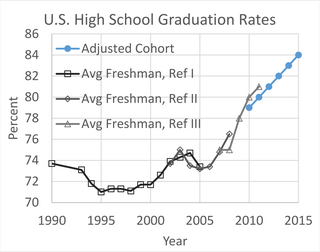
Education in China is a state-run system of public education run by the Ministry of Education. All citizens must attend school for at least nine years, known as the nine-year compulsory education, which is funded by the government. Compulsory education includes six years of primary education, typically starting at age six or seven, followed by three years of junior secondary education. Some provinces may have five years of primary school but four years for junior middle school. After junior middle school, there are three years of senior middle school, which then completes the secondary education.
The University of Phoenix (UOPX) is a for-profit university headquartered in Phoenix, Arizona. Founded in 1976, the school confers certificates and degrees in over 100 certificate programs and degree programs at the certificate, associate, bachelor's, master's, and doctoral degree levels. It is regionally accredited by the Higher Learning Commission and has an open enrollment admission policy, accepting all applicants with a high-school diploma, GED, or its equivalent as sufficient for admission. In 2017, the school's parent company, Apollo Education, was acquired by Apollo Global Management, an American private equity firm.
The Art Institutes are a collection of for-profit art schools that are owned by Education Principle Foundation and the remnants of two failed parent companies: for-profit college operator Education Management Corporation (EDMC) and Dream Center Education Holdings (DCEH).
Student financial aid in the United States is funding that is available exclusively to students attending a post-secondary educational institution in the United States. This funding is to assist in covering the many costs incurred in the pursuit of post-secondary education. Financial aid is available from federal and state governments, educational institutions, and private organizations. It can be awarded in the form of grants, loans, work-study, and scholarships. In order to apply for federal financial aid, students must first complete the Free Application for Federal Student Aid (FAFSA).
Institutional research is a broad category of work done at schools, colleges and universities to inform campus decision-making and planning in areas such as admissions, financial aid, curriculum assessment, enrollment management, staffing, student life, finance, facilities, athletics, and alumni relations.

Higher education in the United States is an optional stage of formal learning following secondary education. Higher education, is also referred as post-secondary education, third-stage, third-level, or tertiary education. It covers stages 5 to 8 on the International ISCED 2011 scale. It is delivered at 4,360 Title IV degree-granting institutions, known as colleges or universities. These may be public or private universities, liberal arts colleges, community colleges, or for-profit colleges. US higher education is loosely regulated by several third-party organizations.
College admissions in the United States refers to the process of applying for entrance to institutions of higher education for undergraduate study at one of the nation's colleges or universities. For those who intend to attend college immediately after high school, the college search usually begins in the eleventh grade of high school with most activity taking place during the twelfth grade, although students at top high schools often begin the process during their tenth grade or earlier. In addition, there are considerable numbers of students who transfer from one college to another, as well as adults older than high school age who apply to college. In 2019, more than 50 people were charged regarding an admissions cheating scheme.

In college athletics in the United States, recruiting is the process in which college coaches add prospective student athletes to their roster each off-season. This process typically culminates in a coach extending an athletic scholarship offer to a player who is about to be a junior in high school or higher. There are instances, mostly at lower division universities, where no athletic scholarship can be awarded and where the player pays for tuition, housing, and textbook costs out of pocket or from financial aid. During this recruiting process, schools must comply with rules that define who may be involved in the recruiting process, when recruiting may occur and the conditions under which recruiting may be conducted. Recruiting rules seek, as much as possible, to control intrusions into the lives of prospective student-athletes. The NCAA defines recruiting as “any solicitation of prospective student-athletes or their parents by an institutional staff member or by a representative of the institution’s athletics interests for the purpose of securing a prospective student-athlete’s enrollment and ultimate participation in the institution’s intercollegiate athletics program."
The Enrollment Management Association, formerly known as the Secondary School Admission Test Board (SSATB), is a nonprofit organization founded in 1957 in the United States by independent school admission officers with three goals in mind: to provide a forum for exchange and support among admission professionals, to create an admission test for use by private schools, and to assist parents and students in their independent school search.
The Integrated Postsecondary Education Data System (IPEDS) is a system of interrelated surveys conducted annually by the National Center for Education Statistics (NCES), a part of the Institute for Education Sciences within the United States Department of Education. IPEDS consists of twelve interrelated survey components that are collected over three collection periods each year as described in the Data Collection and Dissemination Cycle. The completion of all IPEDS surveys is mandatory for all institutions that participate in, or are applicants for participation in, any federal financial assistance program authorized by Title IV of the Higher Education Act of 1965, as amended. Statutory Requirements For Reporting IPEDS Data
Thomas Joseph Kane is a U.S.-American education economist who currently holds the position of Walter H. Gale Professor of Education and Economics at the Harvard Graduate School of Education. He has performed research on education policy, labour economics and econometrics. During Bill Clinton's first term as U.S. President, Kane served on the Council of Economic Advisers.
NAFSA: Association of International Educators is a non-profit professional organization for professionals in all areas of international education including education abroad advising and administration, international student advising, campus internationalization, admissions, outreach, overseas advising, and English as a Second Language (ESL) administration. As of 2010, it served approximately 10,000 educators worldwide, representing nearly 3,000 higher education institutions.
The Common Data Set is a product of the Common Data Set Initiative, "a collaborative effort among data providers in the higher education community and publishers as represented by the College Board, Peterson's, and U.S. News & World Report." The stated goal is to provide accurate and timely data to students and their families while decreasing the workload of administrators. In producing their popular publications and rankings, these publishers "ask the same core questions" of institutions using the Common Data Set to define those questions and their responses. These data are also used in public accountability efforts such as the Voluntary System of Accountability's College Portrait.
Strategic enrollment management [SEM] is a crucial element of planning for new growth at a university or college as it concerns both academic program growth and facilities needs. SEM focuses on what is best for students' success while increasing enrollment numbers and stabilizing institutional revenues. A student's success, according to an enrollment manager, is often based on the institution's graduation and retention rates. This means that students are often recruited based on the likelihood of them graduating. While this practice is acceptable for many privately run selective institutions, it is not a common practice of most public institutions such as community colleges. A real strategic enrollment management approach looks at the entire student cycle, from entry through graduation.

In the United States, community colleges, are primarily two-year public institutions of tertiary education. Many community colleges also offer remedial education, GEDs, high school diplomas, technical degrees and certificates, and a limited number of 4-year degrees. After graduating from a community college, most students transfer to a university or liberal arts college to complete a bachelor's degree, while others enter the workforce.

The graduation completion rate is the measure reflecting the number of students who complete their graduation and receive a degree from an educational institution. The drop-out rate is the measure reflecting the number of students who disengage with the educational institutions they are enrolled in. Those measures are calculated by the National Center for Education Statistics (NCES), the primary federal U.S. entity for collecting and analyzing data related to education.
Sundar Kumarasamy joined Northeastern University as the Vice President of Enrollment Management in June 2015; he is responsible for undergraduate admissions and enrollment marketing, student financial services, and enrollment research, and also plays a role in student retention efforts.
For-profit higher education in the United States consists of higher education educational institutions operated by profit-seeking businesses. However, as the blurring of public and private continue, for-profit education also includes for-profit mechanisms such as endowment money managers, for-profit fees for service, for-profit marketing, enrollment services and lead generation, privatized campus services, for-profit online program managers (OPMs), privatized housing, private student loans, student loan servicers, and Human Capital Contracts, also known as income share agreements.
Graduate Enrollment Management (GEM) is an area of Enrollment management focused on graduate and professional education.